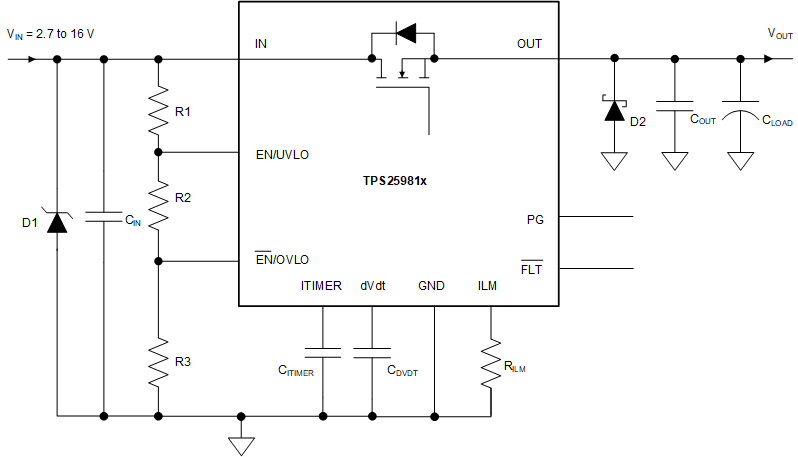SLVSGG6B april 2022 – june 2023 TPS25981
PRODUCTION DATA
- 1
- 1 Features
- 2 Applications
- 3 Description
- 4 Revision History
- 5 Device Comparison Table
- 6 Pin Configuration and Functions
- 7 Specifications
-
8 Detailed Description
- 8.1 Overview
- 8.2 Functional Block Diagram
- 8.3
Feature Description
- 8.3.1 Undervoltage Lockout (UVLO and UVP)
- 8.3.2 Overvoltage Lockout (OVLO)
- 8.3.3 Inrush Current, Overcurrent, and Short-Circuit Protection
- 8.3.4 Analog Load Current Monitor
- 8.3.5 Overtemperature Protection (OTP)
- 8.3.6 Fault Response and Indication (FLT)
- 8.3.7 Power Good Indication (PG)
- 8.3.8 Quick Output Discharge (QOD)
- 8.3.9 Reverse Current Blocking FET Driver
- 8.4 Device Functional Modes
- 9 Application and Implementation
- 10Power Supply Recommendations
- 11Layout
- 12Device and Documentation Support
- 13Mechanical, Packaging, and Orderable Information
Package Options
Mechanical Data (Package|Pins)
- RPW|10
Thermal pad, mechanical data (Package|Pins)
Orderable Information
10.1 Transient Protection
In the case of a short-circuit and overload current limit when the device interrupts current flow, the input inductance generates a positive voltage spike on the input, and the output inductance generates a negative voltage spike on the output. The peak amplitude of voltage spikes (transients) is dependent on the value of inductance in series to the input or output of the device. Such transients can exceed the absolute maximum ratings of the device if steps are not taken to address the issue. Typical methods for addressing transients include:
- Minimize lead length and inductance into and out of the device.
- Use a large PCB GND plane.
- Connect a Schottky diode from the OUT pin ground to absorb negative spikes.
- Connect a low ESR capacitor larger than 1 μF at the OUT pin very close to the device.
- Use a low-value ceramic capacitor CIN
= 1 μF to absorb the energy and dampen the transients. The capacitor voltage
rating must be at least twice the input supply voltage to be able to withstand
the positive voltage excursion during inductive ringing.
Use Equation 15 to estimate the approximate value of input capacitance:
Equation 15.where
- VIN is the nominal supply voltage.
- ILOAD is the load current.
- LIN equals the effective inductance seen looking into the source.
- CIN is the capacitance present at the input.
- Some applications can require the addition of a Transient Voltage Suppressor (TVS) to prevent transients from exceeding the absolute maximum ratings of the device. In some cases, even if the maximum amplitude of the transients is below the absolute maximum rating of the device, a TVS can help to absorb the excessive energy dump and prevent it from creating very fast transient voltages on the input supply pin of the IC, which can couple to the internal control circuits and cause unexpected behavior.
Figure 10-1 shows the circuit implementation with optional protection components.
 Figure 10-1 Circuit Implementation with
Optional Protection Components
Figure 10-1 Circuit Implementation with
Optional Protection Components